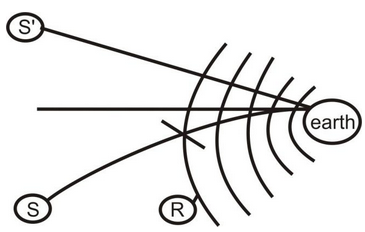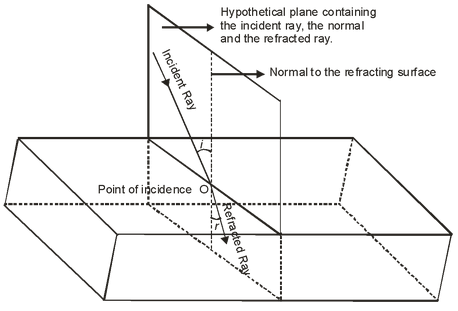
Refraction Of Light
Light of Class 10
REFRACTION OF LIGHT
When light travels in the same homogeneous medium it travels along a straight path. However, when it passes from on transparent medium to another, the direction of its path changes at the interface of the two media. This is called refraction of light.
The phenomenon of the change in the path of the light as it passes from one transparent medium to another is called refraction of light. The path along which the light travels in the first medium is called incident ray and that in the second medium is called refracted ray. The angles which the incident ray and the refracted ray make with the normal at the surface of separation are called angle of incidence (i) and angle of refraction (r) respectively.

Incident ray Normal Refracted ray
(a) (b) (c)
Showing different cases of refraction
It is observed that:
- When a ray of light passes from an optically rarer medium to a denser medium it bends towards the normal(∠r < ∠i), as shown in figure (a).
- When a ray of light passes from an optically denser to a rarer medium it bends away from the normal (∠r> ∠i) as shown in figure (b).
- A ray of light traveling along the normal passes undeflected, as shown is figure (c). Here ∠i = ∠r = 0 o .
Cause of Refraction:
We come across many media like air, glass, water etc. The medium we study are usually transparent material through which the light is transmitted. Every transparent medium has a property known as optical density. The optical density of a transparent medium is closely related to the speed of light in the medium. If the optical density of a transparent medium is low, then speed of light in that medium is high. Such a medium is known as an optically rarer medium. Thus, optically rarer medium is that medium through which light travels fast. In other words, a medium in which speed of light is more is known as optically rarer medium.
On the other hand, if the optical density of transparent medium is high, then the speed of light in that medium is low. Such a medium is known as an optically denser medium. Thus, optically denser medium is that medium through which light travels slow. In other words, a medium is which speed of light is less is known as optically denser medium.
Speed of light in air is more than the speed of light in water, so air is optically rarer medium as compared to the water. In other words, water is optically denser medium as compared to air. Similarly, speed of light in water is more that the speed of light is glass, so water is optically rarer medium as compared to the glass. In other words, glass is optically denser medium as compared to water.
When light goes from air (optically rarer medium) to glass (optically denser medium) such that the light in air makes an angle with the normal to the interface separating air and glass, then it bends from its original direction of propagation. Similarly, if light goes from glass to air, again it bends from its original direction of propagation. The phenomena of bending of light from its path is known as refraction. We have seen that the speed of light in different media is different, so we can say that refraction of light takes place because the speed of light is different in different media. Thus, the cause of refraction can be summarized as follows:
- Refraction is the deviation of light when it crosses the boundary between two different media (of different optical densities) and there is a change in both the wavelength and the speed of light.
- The frequency of the refracted ray remains unchanged.
- The intensity of the refracted ray is less than that of the incident ray. It is because there is partial reflection and absorption of light at the interface.
Effects of refraction of Light:
- If a straight stick is partially put in water, it appears to be bent.
- If we see a water tank its bottom appears to e raises. It also appears to be concave shaped although it is flat.
- The sun is visible a few minutes earlier than it actually rises above horizon, because as we go up from earth, the density of air layer decrease, then rays from sun keep on bending towards normal till it enters the eye.
 Sun appears to be at S’. For the same reason it keeps on appearing two minutes after sun-set. Hence the day i.e. the time between the sunrise & sunset becomes four minutes longer. The day therefore gets longer by 4 minutes.
Sun appears to be at S’. For the same reason it keeps on appearing two minutes after sun-set. Hence the day i.e. the time between the sunrise & sunset becomes four minutes longer. The day therefore gets longer by 4 minutes.

Atmosphere
Twinkling of stars:
On a clear night, you might have observed the twinkling of a star, which is due to an atmospheric refraction of star light. The density of the atmosphere, as we know goes on decreasing as the distance above the sea level increase. For the snake of simplicity, air can be supposed to be made up of a very large number of layers show density of which decreases with the distance above the surface of the earth. Therefore, the light from a heavenly body, such as a star, goes on gradually bending towards normal as it travels through the earth’s atmosphere. As the object is always seen in the direction of the light reaching the observer’s eye, the star appears higher up in the sky than its actual position. Further, the densities of the various lavers go on varying due to the convection current set up in air by temperature differences. Thus, the refractive index of layer of air at a particular level goes on changing.
Due to these variations in the refractive indices of the various layers of air, the light from a star passing through the atmospheric air changes its path from time to time and therefore, the amount of light reaching the eye is not always the same. This increase and decrease in the intensity of light reaching the eye results in a change in apparent position or twinkling of the star.
LAWS OF REFRACTION:
Refraction of light occurs according to certain laws, known as the laws of refraction. The following are the two laws of refraction:
(i) First law of refraction of light: According to the first law of refraction of light, “The incident ray, the refracted ray and the normal to the interface of two transparent media at the point of incidence, all lie in the same plane.”

(ii) Second law of refraction: According to the second law of refraction, “The ratio of sine of angle of incidence to the sine of angle of refraction is a constant, for the light of a given colour (wavelength) and for the given pair of media.” This law is also known as Snell’s law of refraction.
i.e., sin i/sin r = constant
where i = angle of incidence
r = angle of refraction.
This constant value is called the refractive index of the second medium with respect to the first.
REFRACTIVE INDEX:
(a) Refractive Index in terms of Speed of Light:
The refractive index of a medium may be defined in terms of the speed of light as follows :
The refractive index of a medium for a light of given wavelength may be defined at the ratio of the speed of light in vacuum to its speed in that medium.
Refractive index =

or

Refractive index of medium with respect to vacuum is also called absolute refractive index.
(b) Refractive Index in terms of Wavelength:
Since the frequency (ν) remain unchanged when light passed from one medium to another, therefore,

The refractive index of a medium may be defined as the ratio of wavelength of light in vacuum to its wavelength in that medium.
(c) Relative Refractive Index:
The relative refractive index of medium 2 with respect to medium 1 is defined as the ratio of speed of light (v1) in the medium 1 to the speed of light (v2) in medium 2 and is denoted by
 .
.
Thus,

As refractive index is the ratio of two similar physical quantities, so it has no unit and dimension.
Factors on which the refractive index of a medium depends are as follows:
- Nature of the medium.
- Wavelength of the light used.
- Temperature.
- Nature of the surrounding medium
It may be note that refractive index is a characteristic of the pair of the media and also depends on the wavelength of light, but is independent of the angle of incidence.
Physical significance of refractive Index:
The refractive index of a medium gives the following two information’s:
- The value of refractive index gives information about the direction of bending of refracted ray. It tells whether the ray will bend towards or away from the normal.
- The refractive index of a medium is related to the speed of light. It is the ratio of the speed of light in vacuum to that in the given medium. For example, refractive index of glass is 3/2. This indicates that the ratio of the speed of light in glass to that in vacuum is 2 : 3 or the speed of light in glass is two-third of its speed in vacuum.
The absolute refractive index of some material media are as follows:
Table: Absolute refractive index of some material media
|
Material medium |
Refractive index |
Material medium |
Refractive index |
|
Air |
1.0003 |
Canada Balsam |
1.53 |
|
Ice |
1.31 |
Rock salt |
1.54 |
|
Water |
1.33 |
Carbon disulphide |
1.63 |
|
Alcohol |
1.36 |
Dense flint glass |
1.65 |
|
Kerosene |
1.44 |
Ruby |
1.71 |
|
Fused quartz |
1.46 |
Sapphire |
1.77 |
|
Turpentine oil |
1.47 |
Diamond |
2.42 |
|
Benzene |
1.50 |
Crown glass |
1.52 |




